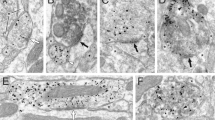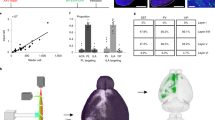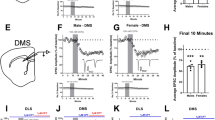Abstract
We found that medium spiny neurons (MSNs) in both the direct and indirect pathways of the mouse nucleus accumbens (NAc) receive inputs from the cortex, thalamus and hippocampus. However, hippocampal inputs were much weaker onto indirect MSNs, where they contacted small spines located in the distal dendrites. This selective targeting means that these inputs must be gated by subthreshold depolarization to trigger action potentials and influence NAc output.
This is a preview of subscription content, access via your institution
Access options
Subscribe to this journal
Receive 12 print issues and online access
$209.00 per year
only $17.42 per issue
Buy this article
- Purchase on Springer Link
- Instant access to full article PDF
Prices may be subject to local taxes which are calculated during checkout



Similar content being viewed by others
References
Russo, S.J. et al. Trends Neurosci. 33, 267–276 (2010).
Sesack, S.R. & Grace, A.A. Neuropsychopharmacology 35, 27–47 (2010).
Stuber, G.D. et al. Nature 475, 377–380 (2011).
Gerfen, C.R. et al. Science 250, 1429–1432 (1990).
Hikida, T., Kimura, K., Wada, N., Funabiki, K. & Nakanishi, S. Neuron 66, 896–907 (2010).
Kravitz, A.V., Tye, L.D. & Kreitzer, A.C. Nat. Neurosci. 15, 816–818 (2012).
Lobo, M.K. et al. Science 330, 385–390 (2010).
Finch, D.M. Hippocampus 6, 495–512 (1996).
French, S.J. & Totterdell, S. J. Comp. Neurol. 446, 151–165 (2002).
Goto, Y. & Grace, A.A. Nat. Neurosci. 8, 805–812 (2005).
O'Donnell, P. & Grace, A.A. J Neurosci 15, 3622–3639 (1995).
Boyden, E.S., Zhang, F., Bamberg, E., Nagel, G. & Deisseroth, K. Nat. Neurosci. 8, 1263–1268 (2005).
Albin, R.L., Young, A.B. & Penney, J.B. Trends Neurosci. 12, 366–375 (1989).
London, M. & Häusser, M. Annu. Rev. Neurosci. 28, 503–532 (2005).
Groenewegen, H.J., Wright, C.I., Beijer, A.V. & Voorn, P. Ann. NY Acad. Sci. 877, 49–63 (1999).
Chen, X., Leischner, U., Rochefort, N.L., Nelken, I. & Konnerth, A. Nature 475, 501–505 (2011).
Little, J.P. & Carter, A.G. J. Neurosci. 32, 12808–12819 (2012).
Jaffe, D.B. & Carnevale, N.T. J. Neurophysiol. 82, 3268–3285 (1999).
Plotkin, J.L., Day, M. & Surmeier, D.J. Nat. Neurosci. 14, 881–888 (2011).
Belujon, P. & Grace, A.A. J. Neurosci. 28, 9797–9805 (2008).
Shuen, J.A., Chen, M., Gloss, B. & Calakos, N. J. Neurosci. 28, 2681–2685 (2008).
Gong, S. et al. Nature 425, 917–925 (2003).
Petreanu, L., Huber, D., Sobczyk, A. & Svoboda, K. Nat. Neurosci. 10, 663–668 (2007).
Franklin, K.B.J. & Paxinos, G. The Mouse Brain in Stereotaxic Coordinates, 3rd edn. (Academic Press, 2008).
Yasuda, R. et al. Sci. STKE 2004, pl5 (2004).
Chalifoux, J.R. & Carter, A.G. J. Neurosci. 31, 4221–4232 (2011).
Carter, A.G. & Sabatini, B.L. Neuron 44, 483–493 (2004).
Rodriguez, A., Ehlenberger, D.B., Hof, P.R. & Wearne, S.L. Nat. Protoc. 1, 2152–2161 (2006).
Dayan, P. & Abbot, L.F. Theoretical Neuroscience: Computational and Mathematical Modeling (MIT Press, 2001).
Carter, A.G. & Regehr, W.G. Nat. Neurosci. 5, 1309–1318 (2002).
Acknowledgements
We thank members of the Carter laboratory, M. Farrant, B. Sabatini and R. Tsien for helpful discussions and comments on the manuscript. This work was supported by the Whitehall Foundation, Dana Foundation and McKnight Foundation (A.G.C.). A.F.M. is a Sir Henry Wellcome Postdoctoral Fellow.
Author information
Authors and Affiliations
Contributions
A.F.M. and A.G.C. designed the experiments. A.F.M. performed experiments and analyzed the data. J.P.L. performed computer simulations. J.M.C. performed stereotaxic injections and confocal microscopy. A.F.M. and A.G.C. wrote the paper.
Corresponding author
Ethics declarations
Competing interests
The authors declare no competing financial interests.
Supplementary information
Supplementary Text and Figures
Supplementary Figures 1–7 (PDF 3372 kb)
Rights and permissions
About this article
Cite this article
MacAskill, A., Little, J., Cassel, J. et al. Subcellular connectivity underlies pathway-specific signaling in the nucleus accumbens. Nat Neurosci 15, 1624–1626 (2012). https://doi.org/10.1038/nn.3254
Received:
Accepted:
Published:
Issue Date:
DOI: https://doi.org/10.1038/nn.3254
This article is cited by
-
Updating the striatal–pallidal wiring diagram
Nature Neuroscience (2024)
-
Cocaine-induced projection-specific and cell type-specific adaptations in the nucleus accumbens
Molecular Psychiatry (2022)
-
Input-specific modulation of murine nucleus accumbens differentially regulates hedonic feeding
Nature Communications (2021)
-
A hypothalamic-thalamostriatal circuit that controls approach-avoidance conflict in rats
Nature Communications (2021)
-
Early-life adversity selectively interrupts the dendritic differentiation of dorsolateral striatal neurons in male mice
Brain Structure and Function (2021)



